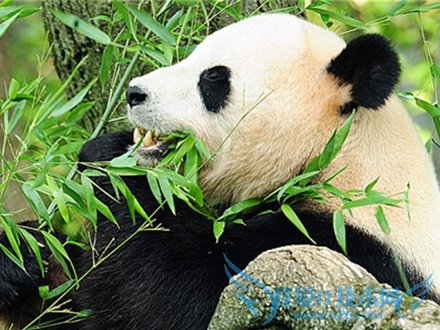��ӭ������52ijӢ��������������С��Ϊ�������Ӣ��֪ʶ�ǣ�������û�뵽�����Ӳ��Ǵ���è������ʳ���������������ϸ�ķ�����
����û�뵽�����Ӳ��Ǵ���è������ʳ���

The mystery of why giant pandas are forced to spend 14 hours a day eating foods has finally been solved - they can only digest around 17 per cent of the bamboo they swallow.����è���ò�һ��14��Сʱ���ڽ�ʳ������������ڱ���ˡ�����ֻ���������17%��ʳ��ȥ�����ӡ�
Researchers found their gut bacteria are not the type for efficiently breaking down bamboo. In fact they are built to eat meat. The giant panda actually harbours a carnivore-like gut, according to the research published in the journal mBio.�о���Ա���ִ���è���ڵ����ֳ���ϸ��������Ч�������ӡ�ʵ��������ȴ��������ʳ���ݡ�mBio���ڿ��������о��ƣ�����è��ʵӵ������ʳ�����Ƶij�����
Pandas are one of the most endangered species on Earth, with only 1,600 animals left in the wild.����è�ǵ��������Σ������֮һ��Ұ������èֻʣ��1600ֻ��
The study's lead author Zhihe Zhang, director of the Chengdu Research Base of Giant Panda Breeding in China, said: "Unlike other plant-eating animals that have successfully evolved, anatomically specialised digestive systems to efficiently deconstruct fibrous plant matter, the giant panda still retains a gastrointestinal tract typical of carnivores.����о��ĵ�һ���ߡ��й��ɶ�����è�������ص�������־��˵��������ֲʳ�Զ����Ѿ������ɹ�������������ר�ŵ�����ϵͳ����Ч�طֽ�ֲ����ά��Ȼ������è����Щ���ﲻͬ�������Ա�������ʳ�Զ��������������

"The animals also do not have the genes for plant-digesting enzymes in their own genome. This combined scenario may have increased their risk for extinction."������è�����Ļ������ﻹû��ֲ������ø�Ļ�����Щ�ۺ����Ҳ����Ӿ����������Σ������
Study co-author Doctor Xiaoyan Pang, an associate professor in the School of Life Sciences and Biotechnology at Shanghai Jiao Tong University, said: "This result is unexpected and quite interesting, because it implies the giant panda's gut microbiota may not have well adapted to its unique diet, and places pandas at an evolutionary dilemma."�����о��Ĺ�ͬ���ߡ��Ϻ���ͨ��ѧ������ѧ�뼼��ѧԺ�ĸ�������С�ʿָ��������һ�о�����������ϣ�����ʮ����Ȥ����Ϊ���������è�ij���ϸ��Ҳ��û�ܺܺõ���Ӧ����è�������ʳ�����ô���è�����������������
The researchers said that giant pandas evolved from bears that ate both plants and meat, and started eating bamboo exclusively about two million years ago.�о���Ա�dzƣ�����è����ʳ���ܽ������������ڴ�Լ��������ǰ��ʼר�����ӡ�

The animals spend up to 14 hours daily consuming up to 12.5 kilos (27.5 pounds) of bamboo leaves and stems, but can digest only about 17 per cent of it; their faeces is mainly composed of undigested bamboo fragments.����èÿ�컨��14��Сʱ���Ķ��12.5���27.5��������Ҷ����ͣ�����ֻ���������17%�����ǵķ������δ���������Ӳ�����ɡ�
The researchers had been intrigued by how the animals digest bamboo fibre and extract nutrients from it.�о���Ա�Դ���è��ô����������ά�����л�ȡӪ�����ʺܸ���Ȥ��
The researchers found that despite their diet, the giant pandas, together with nine captive and seven wild individuals investigated previously, showed extremely low gut microbiota diversity and an overall structure that diverged from non-panda plant-eaters but was similar to carnivorous and omnivorous bears.���Ƿ��־������ǵ���ʳ��ˣ���Щ����è������֮ǰ���о���9ֻȦ������è��7ֻҰ�����壬�����ֳ����͵ij���ϸ�������ԡ��������dz���������Ľṹ��ͬ������ֲʳ�Զ����������ʳ�Ժ���ʳ�Ե������ơ�
- �����б����������۽������ѱ�����˿���������������վͬ����۵��֤ʵ��������
-
